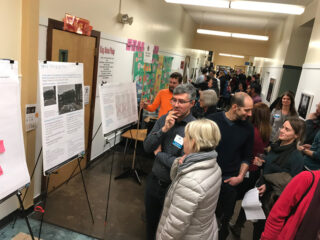
(Photos: J. Maus/BikePortland)
The City of Portland is in the planning stages of their Lloyd to Woodlawn Neighborhood Greenway project and they held the first open house last night.
When complete, the route will connect the forthcoming Sullivan’s Crossing bridge (cross I-84) to Dekum Street in Woodlawn with a low-stress street where people can feel walking and biking.
Billed as a “listening session,” the Bureau of Transportation was careful at last night’s jam-packed event to let residents know they haven’t made any concrete decisions about the designs or the alignment yet. As we reported earlier this month, PBOT has looked at both NE 7th and NE 9th and both streets are still technically on the table. The poster boards shown to attendees at the event were mostly about greenways in general. However, there were some design concepts shown and we learned a few new details about what’s in the works.
In addition to getting our first glimpse at what the future greenway could look like, we also began to see what a future debate about 7th or 9th might look like. Keep in mind that PBOT won’t put the route completely on either street. The two options — as presented last night in the graphic below — include a mix of 7th and 9th or what they’re calling, “NE 7th & Area Mitigation” where PBOT would focus mostly on 7th and heavily monitor adjacent streets to mitigate for any diverted traffic.
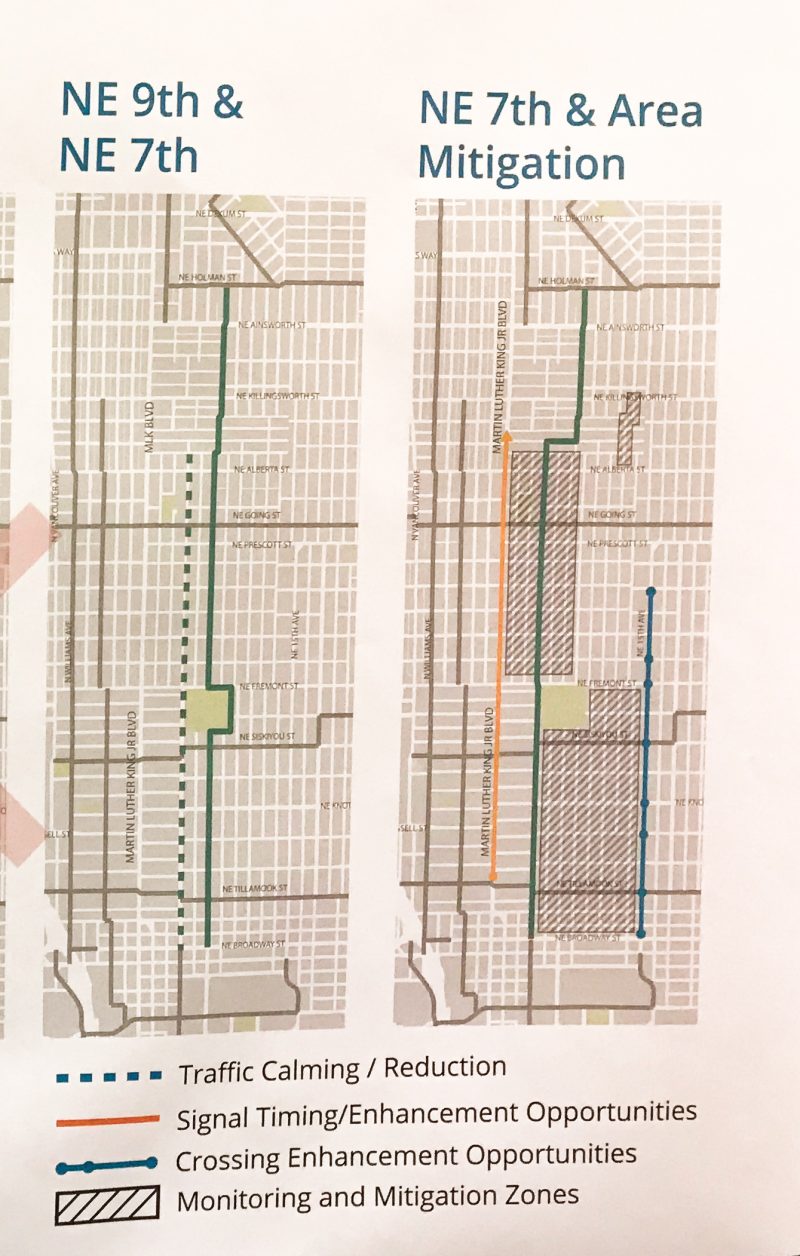
NE 7th & Area Mitigation
In a posterboard, PBOT claimed that after they finish this project NE 7th would, “Be transformed into a calm, local street.” That would be a major lift given that the average daily traffic volume between Broadway and Alberta averages about 5,000 drivers in the bottom half (to Fremont) and about 2,500 per day in the upper half. Those numbers, “far exceed” PBOT’s own guidelines for neighborhood greenways. They aim to create routes with an average of 1,000 drivers a day with 2,000 being the very upper limit. Not only are there a ton of cars being used, people are driving them way too fast. PBOT numbers shared last night revealed that a whopping 26 percent of all auto users on NE 7th between Broadway and Prescott were driving over the posted speed limit (25 mph).
One reason for the volume and speed of drivers on 7th is that it’s a cut-through for Martin Luther King Jr. Blvd a few blocks west. Another PBOT graphic shared last night revealed that only 14 percent of the people driving on 7th are considered “local traffic”. “Long distance neighborhood traffic” and “non-neighborhood traffic” made up 37 percent of the total.
As for what the design might look like, PBOT shared a before/after image of NE 7th north of Fremont. Today that 34-foot cross section includes two standard lanes and an on-street parking in one direction (northbound). The new cross-section would add parking to the west side of the street, remove the centerline, and add speed bumps and sharrows to calm things down. PBOT would also add “frequent and well-placed” diverters along 7th to “dramatically lower cut-through volumes.”
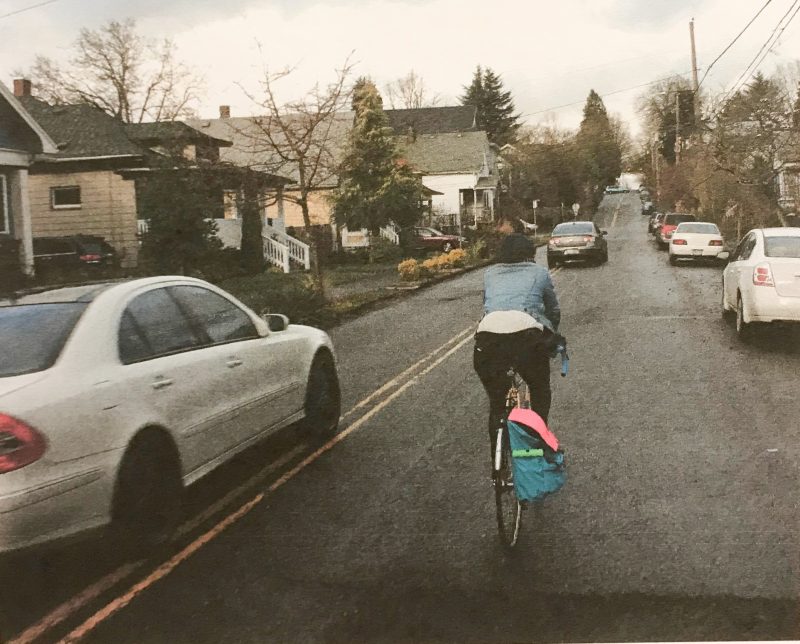

To calm residents who fear such changes to 7th will lead to chaos on other streets, PBOT is being proactive with promises about how they’ll handle that issue. They were eager to tell people they already have funding to update traffic signal equipment on MLK Blvd in order to improve driver flow and capacity on that arterial street. They would also look at operational and signal updates on NE 15th, the other major traffic street to the east.
Advertisement
NE 9th and NE 7th
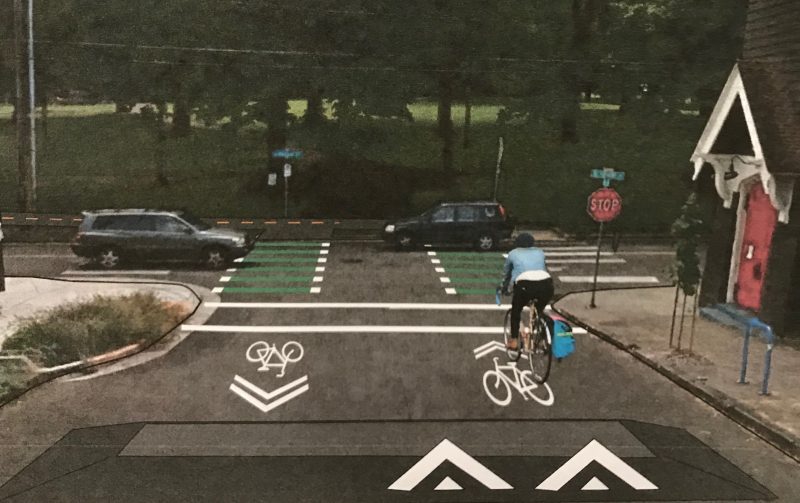
This is the option that seems much less feasible. In this scenario, PBOT would make the greenway on 9th and do some less robust traffic calming on 7th. Community volunteers working with Bike Loud PDX strongly oppose using 9th for a variety of reasons: It doesn’t connect as well with existing bikeways, it has much more elevation gain, and it would require either going up-and-over a big hill in Irving Park or going around the park altogether.
Ironically, PBOT showed a before/after image of the potential design of 9th just south Fremont were the route would essentially dead-end into the park. To get through the park a new path would have to be built and it would likely eat up a huge portion of the project’s $522,000 budget. This option would also not allow PBOT to spend as much on traffic calming for 7th, which they admit would lead to, “Volumes lower than today, but not enough to meet neighborhood greenway guidelines.”
Feedback
With the changes that are likely to come to NE 7th, there will undoubtedly be strong reactions from residents. But from my observation of post-it notes and conversations at the open house, a majority of people prefer 7th. Here are some of those comments:
It should be on 7th. Put lots of diverters!
7th is more direct, less hills, no park in the way.
9th has obvious attributes sought for a bikeway. Solve traffic problems on 7th some other way.
7th is better. Straight, safe route to school. Eyes on school street.
2-sided parking on 7th would be safer for pedestrians and improve livability.
People already use 7th as a N-S bikeway. Keeping it would promote more biking.
As for next steps, PBOT host a series of “community design discussions” in spring and then we’ll see the final proposed designs in June or July. Construction is scheduled to start in 2019. Stay tuned for more coverage and get on the project’s email list on PBOT’s website.
UPDATE, 3:20 pm: If you missed this event, PBOT has just released the official online open house.
— Jonathan Maus: (503) 706-8804, @jonathan_maus on Twitter and jonathan@bikeportland.org
Never miss a story. Sign-up for the daily BP Headlines email.
BikePortland needs your support.



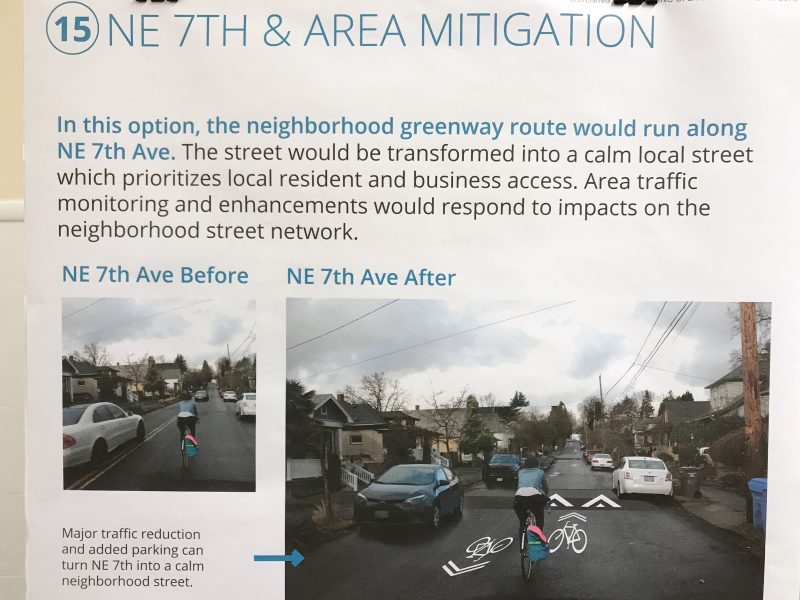
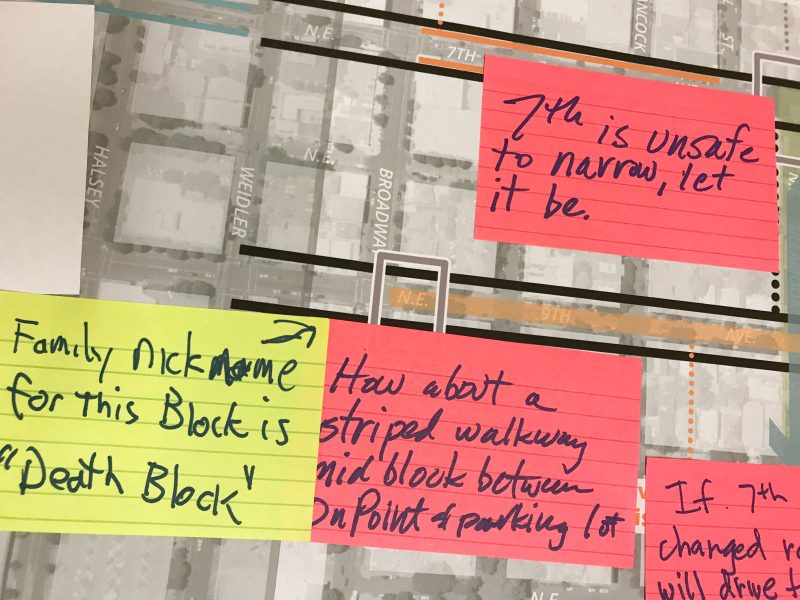

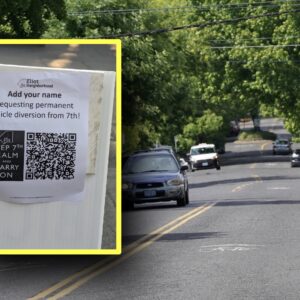
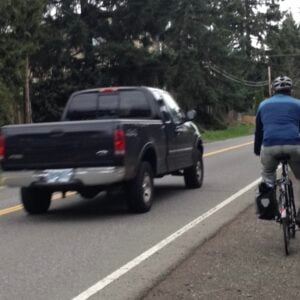

Thanks for reading.
BikePortland has served this community with independent community journalism since 2005. We rely on subscriptions from readers like you to survive. Your financial support is vital in keeping this valuable resource alive and well.
Please subscribe today to strengthen and expand our work.
If they are doubling the parking, can they please daylight the intersections. Not sure why we need parking 2 feet from the crosswalks, blocking the sitelines
ORS 811.550(17) Parking within 20 feet of a crosswalk is illegal.
In Portland it is de facto legal.
Leah Treat has very recently indicated that this may no longer be the case, and that a public statement from PBOT on this issue may be forthcoming. Stay tuned? (In the meanwhile, email her in support of enforcing state law if intersection visibility is an important issue to you!)
Portland has publicly said they don’t enforce this
The actually encourage it. Here’s a paid parking spot (right next to a parking garage) that is 3 feet from a crosswalk:
https://goo.gl/maps/6VbUCjmBz7u
And more, on the same block:
https://goo.gl/maps/jmxMtqo5SUK2
Well, that may be state law but try to find that on the PBOT website! Surprisingly it’s not listed as one of the common parking violations (https://www.portlandoregon.gov/transportation/article/59926).
If it were enforced in a number of close-in neighborhoods it would be full employment for parking enforcement for quite some time!
agreed if the parking is for calming then they should be able to remove the spaces from the corners without lowering the overall parking by adding those spaces back in on the other side of the street away from the intersection. Would be nice to see planters or something else to prevent parking in these spots as enforcement would likely be spotty and ineffective.
Making it even worse, there is a row of badly placed newspaper vending boxes on the Starbucks (police hangout) side of Fremont that blocks access to the sidewalk when crossing there.I get off the bike at that crosswalk because of the speed of cars on Fremont but often have to walk the bike around those boxes and a parked car to get to the shopping center.
Cue the bike-hating NIMBYs.
It was calm before everyone moved here. No Warriors jerseys either.
I’m totally with you. We need to build a wall between here and California. Make California pay for it. #MOGA
Says to himself, “OK, early in the design, so don’t get too worked up …”
No one is expecting new parking supply along 7th. Instead of converting super-valuable street space to CAR STORAGE, why isn’t a two-way protected bike lane under consideration for the 8 – 9 feet of cross-section that will be freed up with this plan?
May be this is a misguided attempt at making the project more palatable to neighbors? Some kind of karma contribution to the car gods?
I understand there is a calming effect when the street is narrowed and crowded … but let’s accomplish that effect with bike infrastructure instead of car parking.
With the complete lack of tenacity to remove parking [the doctor can’t even feel them when PBOT coughs], this proposed parking ADDITION will likely not be reversed for a very long time.
And of course, the trend is away from free parking, so once this area is permitted/metered, the happy glow on the car parkers’ face dissipates and we have lost – true net loss – street space to more car storage.
I just can’t believe I have to write this in 2018, with the policy directives already in place for the City, esp. PBOT. We need to deter [parking and] driving, plain and simple.
Yep. What is preventing PBOT from redesigning 7th into a 1-way for cars with a 2-way cycle track? It will be much more difficult in the future if this is turned into a greenway now.
Amazing idea. Here’s a quick mockup I made: https://imgur.com/a/IXoyW
Complete with car driving in the bike lane!
the street is quite a bit wider than your mockup would indicate. Esp if they tore out the roundabouts
Yeah, in reality it’d be two lanes for cars, two lanes for bikes
I shared PBOT’s design plan with my wife yesterday and she was surprised that they would not put a separate bike lane in it. And I was surprised that I had not thought about it … probably because bike greenway means sharrows and shared space. I hope that infrastructure option is within PBOT’s toolset for greenways because I see no other way to make the street comfortable for bike riders.
This came up during PBOT’s back and forth on the Lincoln-Harrison greenway improvements after it was suggested that the greenway turn into bike lanes around Lincoln and 50th-55th. PBOT’s response was that putting in a separate bike lane is associated with folks in cars driving faster (I think because the road feels wider) and creating a less comfortable biking environment, and would also have required tearing out the roundabouts that Lincoln has there. I’m guessing the same would be true for 7th.
Removes all parking from 7th. Cars going in and out of driveways on either side would have to drive over the bike path, drive through bollards. Delivery vehicles would have nowhere to stop without completely blocking either car or bike traffic. Fire trucks would have difficult access to hydrants. I think this plan won’t work. Maybe for a wider street that isn’t lined with houses.
7th is 4 lanes wide, 3 lanes wide north of Fremont. One lane for a 2-way protected bike lane and bollards, one 8′ lane for parking, one lane for car traffic. This retains current parking and creates a place where kids can finally use the street safely. No diverters necessary.
With a crossing every 50 feet! no thanks
With each crossing (driveway) used a frequency of twice a day?
at a minimum and during high use time. Plus deliveries…
Zach,
Here’s an actual street in Portland:
https://goo.gl/maps/JFChHKeYb6u
Fantastic for short distances and narrower streets. 34th is approximately 24′ wide, not quite enough for a two-way separated cycle track. At its narrowest 7th is 30′ wide, plenty of room for a separated cycle track, parking, and a one way street…. or a just some sharrow marks and a lot more parking. What option does PBOT want Portland’s future to look like more?
2-way cycle tracks have safety issues and are a bit much for low volume greenway applications.
The vast majority of people on bikes don’t want to ride with cars on Vancouver/Williams and would otherwise take a PBL despite having a less direct route. Could it be possible that the current low volume is a reflection of the present unsafe conditions? Count the swimmers crossing the river before building the bridge?
What evidence do you have that the vast majority of people don’t want to ride with cars on Vancouver/Williams? Vancouver/Williams is very well used, and a protected bike lane would not protect people from left hooks at intersections.
If they select 9th, Irving Park would need substantial work to avoid creating a lot of conflicts- it is not merely adding a path. The path would skirt a playground and ball fields that currently have very little to prevent people moving freely across the park east-west. Adding a significant path would suggest a big redesign that re-works much of the park’s circulation and probably include some planting/low fences to control and limit access across the new path.
Not to mention the steep downhill where the park ends at Fremont and 9th continues. This might be ok traveling north to south, as shown by the above picture provided by PBOT, but people traveling the other direction would come down fast the hill and then would need to stop at Fremont. And how would that work if there are a bunch of people biking that way, where will they wait?
Clearly there would have to be a cut in the bank to reduce the grade. It’s steep even for a driveway. A cut in the bank would take space from the park.
Have you visited Benedict Park, the Bush greenway travels through it east of 100th on a bike path.
Not a very relevant comparison: the bike lane is at the far western edge of Benedict Park so it do does not bisect any park uses and it is integrated into the Park’s circulation System. Irving park would need a new path that runs immediately adjacent to a playground and a sports field. Also, the bike path in Benedict Park is the the terminus of a greenway, Irving Park is in the middle of the route and in a location where bike traffic would be expected to be much higher.
The Irving Park path is proposed to run along the outside edge of the park, similar to Benedict Park (south side BTW).
To build a path around the south side of Irving park would either impact the trees or the ball fields- both pretty negative IMO
I love the idea of 7th- with the improvement in place through the Lloyd district and forthcoming Sullivan’s crossing bridge, it seems like the natural choice. 7th already has a signal at Fremont creating a safe crossing for people on bikes. Additionally, it is closer to the many destinations on MLK. I hope PBOT will consider extending the bike lanes on Skidmore from N Michigan to NE 7th to provide a straight, safe way to cross the busy streets and access the commercial districts and bike facilitites
Folks, if you were unable to attend the Open House but still want toPBOT to hear your opinions, you can:
1) View the Open House materials here:
https://www.portlandoregon.gov/transportation/article/674874
2) Submit your comments to Project Manager Nick Falbo at nick.falbo@portlandoregon.gov
(All linked to at the project home page at https://www.portlandoregon.gov/transportation/75668 )
Thanks for covering this, Jonathan,
Ted Buehler
Boise Neighborhood resident.
Adding back parking to narrow the street is a terrible idea.
It works well if you’re trying to traffic calm a non-greenway. But if you look at the narrow greenways in the city, such as SE 16th through Ladd’s Addition, or the eastern portion of the Clinton-Woodward greenway, narrowing the roadway greatly reduces comfort and ease of use. Either cars still try and squeeze around you with only inches to spare (as is the case on eastern Clinton), or the cyclist has to pull over to let the car pass (as is the case on 16th; while the driver could be the one to pull over, since bikes are smaller and more nimble it’s usually just easier for us to pull over). Especially on 16th, I cycle slower than usual because cars pulling out from driveways/side streets have to take up most of the roadway when turning, which could cause a head-on collision if I’m traveling fast.
The 1000-2000 vpd metric is ideal for wider greenways (like the western portion of Clinton between 12th-CChavez), but for a street so narrow two cars would struggle to pass each other, even 1000 vpd is undesirable, especially on uphill stretches where bikes are traveling much slower than the vehicular traffic stuck behind them. If PBOT is serious about moving forward with this significantly-narrowed vision of 7th, they’d better be ready to put diversion up every 1/8-1/4 mile.
How about the 34th south of Division model?
I think 34th’s “one-way shared lane, opposite-way curb-side bike lane” design works well for short distances on naturally space-constrained streets (like SE 34th or 16th south of Hawthorne), given that it’s implemented only for a block or two, or when traffic in the shared lane is low-volume and local-only (since there’s not space for legal passing). The design could also be well-utilized as diversion in the Central City, and on routes with short, steep uphill portions (assuming the bike lane goes uphill, of course).
One major drawback is that unless the bike lane is 8’+, this design eliminates the “can ride side-by-side” social appeal of greenways, so I wouldn’t recommend its utilization except on streets that are naturally narrow, and where adjacent properties do not have dedicated parking. If the properties have dedicated parking, removing on-street parking on one/both sides thereby widening the street to typical greenway widths should be the course of action. If the street is not sufficiently traffic calmed without the parking, then PBOT should be looking at either more diversion, chicanes, or protected bike lanes. Parked cars make for poor traffic calming compared to, say, planters, as you can’t guarantee their presence, they block visibility for side streets and driveways, plus the whole door-zone issue. Since there’s not universal understanding of why it’s a bad idea for people on bikes to ride as close to the curb as possible (e.g. veering in-and-out of empty parking spaces and riding in the door zone), I’ve witnessed conflict on greenways before from impatient drivers angry that the bike is “hogging the whole roadway so I can’t pass.” I’ve even been chided by other bike riders for not “sharing the road” properly while riding directly over the sharrows on Clinton.
The one way shared with contra-flow bike lane works in many local street situations.
A 36 foot wide street can be allocated 7′ parking/14 ft one way shared/7′ parking/8′ bike space. with the contra-flow layout cyclists approach parked cars facing a driver, so dooring is much less likely. The bike space could also be allocated as 2′ buffer+6 foot lane.
That can work for a short stretch, but I dot prefer it for a long route like 7th because of the cross street danger. Cars will see the one way sign and not look for bikes. You see it all over town with sidewalks. Add a bit of speed on a bike and it is not very safe
At that point, why even bother with the shared lane? Just build a protected bike lane for both directions of bike travel. I don’t want cars trying to pass me in a 14′ lane with parking on both sides. Protected bike lanes are much more comfortable than greenways; we build greenways because they’re supposedly cheaper and simpler to construct, and easier politically. However if you’re already going through the hassle of building a parking-protected bike lane for one direction, why not go ahead and do so for both directions?
I also share concerns about not being expected by cars when cycling the “wrong way” down one-way streets.
UPDATE, 3:20 pm: If you missed this event, PBOT has just released the official online open house.
Does anyone know when the MLK signal timing project will happen? I feel like I’ve been hearing about it for at least two years, though I suppose I could be thinking of different projects.
The “cut-through for Martin Luther King Jr. Blvd a few blocks west” is actually just one block away. Eliot blocks are long and the streets are wide. Every street between Russell and Fremont desperately needs speed bumps, but that’s a different story.
“[O]nly 14 percent of the people driving on 7th are considered ‘local traffic'” surprising absolutely nobody who even occasionally rides there. A lingering shadow is practically guaranteed almost any day and time you take it northbound (uphill) as if they have no other route.
LOL, I’ll believe it when I see it, and the end product actually has to be usable and safe for cyclists.
I don’t think radical changes to 7th street itself are necessary. Several diverters and several stop signs, strategically placed, would make it unwelcoming for cut through traffic. Then speed bumps and signage. This works for Ankeny and Clinton.
those trees in the middle of the road were meant to calm the street and they close to do nothing. Try driving down the street at the speed limit and you darn near get run over. There are speed bumps on knott between 7th and 15th and all day all you hear are people scraping over them, doing way over the speed limit. Why doesn’t the city look into literally blocking through traffic every few blocks with planters so that cars can’t drive straight down 7th?
The trees are not to slow down traffic, but to prevent the view along the road. The circles are not circles, they are D shaped, so no slowing effect northbound.
are you describing the proposed circles or the existing? I am pretty sure the existing ones are round(?)
If we want to maintain the status quo this is the design. Greenways are shared zones period. We have seen greenways with 1-2k or more cars per day. Sharing space with cars is scary to some people, and unsafe for kids. So we can decide to design something that is just ok, or have dedicated space for bikes that families can actually use.
If greenways were the answer to increasing mode share, Portland would have not stagnated at 7% for a decade.
Changing 7th to a obne way street with a 2-way bike facility STILL shares the road with cars, just in a different way. Cars and delivery drivers will be crossing the bike lane every 50′ at driveways and every 200 feet at intersections. If you have bikes going the opposite direction of cars, those bikes are in real danger at every intersection because some significant portion of people driving will only be checking for on-coming motor vehicles when crossing the road. Don’t believe me? try walking against traffic on Grand or MLK in the Cnetral Eastside midday.
https://nacto.org/case-study/two-way-cycle-track-15th-street-washington-d-c/
15th NW in DC has issues certainly, mediated by LPI and protected intersections, but it has been working quite well for many years.
7th will not be closed to cars, so some sharing will be required.
just some good new pavement would help, like at 7th and Tillamook
9th avenue makes no sense. 7th already has traffic lights at 3 very busy intersections (Fremont, Prescott & Alberta). Plus, the city acknowledges drivers are inappropriately using 7th as a cut-through, despite running past 2 parks and a school. Seems like a perfect place for a road diet to me.
For people who still doubt the potential for a separated cycle track on 7th, Seattle’s Linden Ave provides yet another example of how well it works (perhaps even better if 7th were converted to a one-way). While Portland stagnates and considers mediocre infrastructure upgrades in coordination with adding parking, other cities are installing infrastructure that has been gold standard for decades.
https://www.youtube.com/watch?v=G3fqq3LIbb8
Since there is a congestion problem for northbound evening motor vehicle traffic in North and Northeast Portland (on Interstate, Gibbs, I-5, Williams, MLK, NE 7th, and so on to the East) we could apply a realpolitik solution and split NE 7th into a northbound auto lane and an adjoining two-way cycle track, buffered by cars parked in the strip between. Signals could timed to keep the flows separate at major intersections and a few points in between, such as Tillamook.
Don’t get me wrong–this sounds appalling but my ideas were slightly modified by the video linked by eawriste above.
https://www.youtube.com/watch?v=G3fqq3LIbb8
For those who want anything but that, my preferred option: A parking-free NE 7th with those g-d little single-tree bubble not-roundabout thingies replaced by diverters that allow people on bikes to pass but no other through traffic. The street would be *unstriped* but have local delivery parking spots, street furniture and planters near the margins, basketball goals and similar play structures every block or so. Parts of the surface could be porous, with a reasonably straight continuous line of pavement through the middle for wheeled vehicles. Existing driveways would be marked with differing pavement or pavers so that people are aware of potential conflicts. On-street car parking would be relegated to the side streets off the greenway.
It’s a pretty clear choice. I live on NE 8th and I could deal with either one, and I’d be happy to let the people who actually live on the street make the decision. What I don’t want is a bunch of confusing half-measures meant to accommodate every use but ultimately pleasing nobody. I’m tired of the splotches and stripes of paint applied somewhat at random, mainly serving to show where car tires are actually traveling.